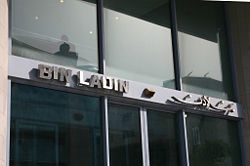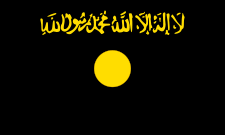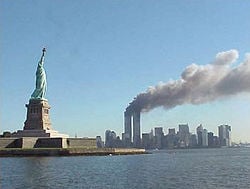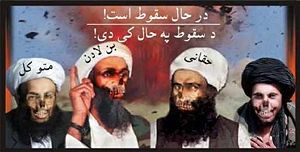Difference between revisions of "Osama bin Laden" - New World Encyclopedia
| Line 83: | Line 83: | ||
===September 11 attacks=== | ===September 11 attacks=== | ||
| − | [[Image:6-wtc-photo.jpg|thumb|250px|Aftermath of the World Trade | + | [[Image:National Park Service 9-11 Statue of Liberty and WTC fire.jpg|thumb|left|250px|The World Trade Center towers just after being hit]] |
| + | [[Image:6-wtc-photo.jpg|thumb|250px|Aftermath of the World Trade Center attacks]] | ||
The [[Federal Bureau of Investigation]] has stated that evidence linking Al-Qaeda and bin Laden to the attacks of September 11, 2001 is clear and irrefutable, and bin Laden himself has claimed responsibility for the attacks. The attacks involved the hijacking of [[United Airlines Flight 93]], [[United Airlines Flight 175]], [[American Airlines Flight 11]], and [[American Airlines Flight 77]]; the subsequent destruction of those planes and the [[World Trade Center]] in [[New York City]], [[New York]]; severe damage to [[The Pentagon]] in [[Arlington, Virginia]]; and the deaths of 2,974 people excluding the [[Organizers_of_the_September_11_attacks#List_of_the_hijackers|nineteen hijackers]]. In response to the attacks, the United States demanded that the Taliban withdraw its protection of bin Laden and his terrorist training camps in Afghanistan and launched a [[War on Terrorism]] to depose the [[Taliban]] regime in [[Afghanistan]] when the government refused to cooperate in the capture of Bin Laden and other al-Qaeda operatives. | The [[Federal Bureau of Investigation]] has stated that evidence linking Al-Qaeda and bin Laden to the attacks of September 11, 2001 is clear and irrefutable, and bin Laden himself has claimed responsibility for the attacks. The attacks involved the hijacking of [[United Airlines Flight 93]], [[United Airlines Flight 175]], [[American Airlines Flight 11]], and [[American Airlines Flight 77]]; the subsequent destruction of those planes and the [[World Trade Center]] in [[New York City]], [[New York]]; severe damage to [[The Pentagon]] in [[Arlington, Virginia]]; and the deaths of 2,974 people excluding the [[Organizers_of_the_September_11_attacks#List_of_the_hijackers|nineteen hijackers]]. In response to the attacks, the United States demanded that the Taliban withdraw its protection of bin Laden and his terrorist training camps in Afghanistan and launched a [[War on Terrorism]] to depose the [[Taliban]] regime in [[Afghanistan]] when the government refused to cooperate in the capture of Bin Laden and other al-Qaeda operatives. | ||
Revision as of 22:23, 22 December 2008
| Osama bin Laden | |
|---|---|
| 10 March 1957 (age 67) | |
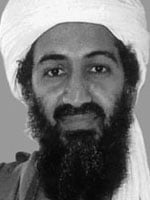 Osama bin Laden from the FBI's "Ten Most Wanted" list | |
| Place of birth | Riyadh, Saudi Arabia |
| Battles/wars | Afghan Jihad 1998 US embassy bombings 2001 World Trade Center bombings War on Terrorism |
Osama bin Laden (Arabic: أسامة بن محمد بن عوض بن لادن transliteration: Usāmah bin Muḥammad bin `Awaḍ bin Lādin; with numerous variations) (born March 10, 1957) is the founder of militant Islamic al-Qaeda movement, best known for masterminding the September 11, 2001 attacks on the United States. A member of the prominent Saudi bin Laden family, Osama used his personal wealth the fund the development of al-Qaeda and has been associated with numerous other mass casualty attacks against civilian targets.
Bin Laden's name is transliterated in several ways. The version often used by most English-language mass media is Osama bin Laden. However, most American government agencies, including the FBI and CIA, use either "Usama bin Laden" or "Usama bin Ladin", both of which are often abbreviated to UBL.
Since 2001, Osama bin Laden and his organization have been major targets of the United States' War on Terrorism. Bin Laden and fellow al-Qaeda leaders are believed to be hiding in the border region between Afghanistan and Pakistan.
Childhood, education and marriages
Osama bin Laden was born in Riyadh, Saudi Arabia on March 10 1957. His father, Muhammed Awad bin Laden, was a wealthy businessman with close ties to the Saudi royal family. One more than 50 children he was the only son of Muhammed bin Laden's tenth wife, Hamida al-Attas. Osama's parents divorced soon after he was born, and his mother then married Muhammad al-Attas, who worked at the bin Laden company. The couple had four other children, and Osama lived in the new household with three stepbrothers and one stepsister.
Raised as a devout Sunni Muslim, Osama studied economics and business administration at King Abdulaziz University, where he received a degree in civil engineering. However, at university, bin Laden's main interest seems to have been religion.
In 1974, at the age of 17, he married his first wife, Najwa Ghanem, at Latakia (Laodicea), Turkey. As of 2002 bin Laden had married four women and fathered roughly 25 children.
Teachings
Like many Islamic fundamentalists, bin Laden emphasizes that only the restoration of Sharia law will set things right in the Muslim world. He rejects all other ideologies—"pan-Arabism, socialism, communism, democracy"—must be opposed. During the 1990s, he insisted that Afghanistan under the rule of Mullah Omar's Taliban was "the only Islamic country" in the Muslim world.
Bin Laden has consistently dwelt on the need for external jihad (holy war) to right what he believes are injustices against Muslims perpetrated by the United States and other non-Muslim states. He has also called for the elimination the state of Israel, and the necessity of forcing the US to withdraw from the Middle East.
The most controversial part of bin Laden's ideology is his insistence that civilians, including women and children, can be killed in jihad.[1] He has also delivered warnings against alleged Jewish conspiracies: "These Jews are masters of usury and leaders in treachery," he claims. "They will leave you nothing, either in this world or the next."[2] He lists Shia Muslims as "heretics" and one of the principal "enemies of Islam."[3]
Bin Laden also opposes music on religious grounds. [4] He has also called on Americans to "reject the immoral acts of fornication (and) homosexuality, intoxicants, gambling, and usury."
Militant activity
Mujahideen in Afghanistan
After leaving college in 1979 bin Laden joined militant Palestinian scholar Abdullah Azzam to fight the Soviet Invasion of Afghanistan and lived for a time in Peshawar. By 1984, with Azzam, bin Laden established the Maktab al-Khadamat, known in English as the Afghan Services Bureau, which funneled money, arms, and Muslim fighters from around the Arabic world into the Afghan war. Bin Laden's inherited family fortune and yearly income paid for travel, accommodations, and administrative expenses of the Afghan fighters.
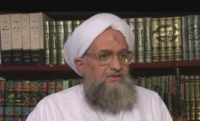
During this time bin Laden met his future al-Qaeda collaborator the Egyptian Ayman al-Zawahiri. Osama then established an operational and training camp in Afghanistan, and fought against the Soviets. By 1988, at al-Zawahiri's urging, bin Laden had split from Maktab al-Khidamat and Azzam, determined to take a more directly military role and insisting that Arab fighters form separate units rather than being integrated into native Afghan Taliban forces.[5]
After the defeat of the Soviets, Bin Laden returned to Saudi Arabia in 1990 as a hero of jihad. However, his militancy soon alienated him from the Saudi elites. When Iraq invaded Kuwait, bin Laden met Crown Prince Sultan and urged him not to cooperate with coalition forces opposed to Saddaam Hussein, offering to use his resources to help defend Saudi Arabia from any Iraqi aggression. When he was rebuffed, bin Laden publicly and bitterly denounced Saudi Arabia's dependence on the US military.
Sudan
Bin Laden moved to Sudan in 1992 and established a new base for operations in Khartoum. Due to his continuous verbal assaults on King Fahd of Saudi Arabia, in 1994 Fahd sent an emissary to Sudan demanding bin Laden's passport. The bin Laden family was persuaded to cut off his monthly stipend, thought to amount to $7 million a year. By now bin Laden was strongly associated with Egyptian Islamic Jihad (EIJ), which made up the core of al-Qaeda. In 1995 the EIJ attempted to assassinate Egyptian President Hosni Mubarak. The attempt failed, and the EIJ was expelled from Sudan.
In late 1995, Sudanese officials discussed with the Saudi government the possibility of deporting Bin Laden to Saudi Arabia, but the Saudis, who had revoked his citizenship, refused. In May 1996, with Sudan under increasing pressure from Saudi Arabia, Egypt, and the United States, bin Laden returned to Afghanistan and forged a close relationship with Taliban leader Mullah Mohammed Omar.
Early terrorist attacks
It is believed that the first terrorist attack involving bin Laden was the December 29, 1992 bombing of the Gold Mihor Hotel in Aden in which two people were killed.[6] It was after this bombing that al-Qaeda began to develop its justification for the killing of innocent people. According to a fatwa—issued to al-Qaeda members but not the general public—by Al Qaeda leader Mamdouh Mahmud Salim, the killing of someone "standing near" the enemy is justified because any innocent bystanders will find their just proper reward in death, going to Paradise if they were true Muslims and going to hell if they were bad Muslims or infidels.[7]
In the 1990s, with bin Laden's aid, al-Qaeda assisted jihadists financially and militarily in Algeria, Egypt, and Afghanistan. In 1992 or 1993 bin Laden sent an emissary, Qari el-Said, with $40,000 to Algeria to aid Islamists there, urging armed struggle rather than negotiation with the government. The advice was heeded, but the civil war that followed killed 150,000-200,000 Algerians and ended with Islamist forces surrendering to the government. Another attack funded by bin Laden was the Luxor massacre of November 17, 1997, which killed 62 civilians. This action disgusted the Egyptian public and turned it against Islamist terror. In mid-1997, the anti-Taliban Northern Alliance threatened to overrun Jalalabad, causing Bin Laden to abandon his compound in Nazim Jihad and move his operations to Tarnak Farms in the south.[8]
In 1998, Bin Laden helped cement his alliance with his Taliban hosts by sending several hundred of his Arab fighters to help the Taliban in a successful attack on the city of Mazar-e-Sharif. More than 8,000 non-combattants were reported killed in Mazar-i-Sharif and later in Bamiyan.
In the same year, bin Laden and Ayman al-Zawahiri co-signed a fatwa in the name of the World Islamic Front for Jihad Against Jews and Crusaders, declaring that the killing of the Americans and their allies was an "individual duty for every Muslim." At the public announcement of the fatwa bin Laden announced that Americans are "very easy targets," boasting to attending journalists that, "You will see the results of this in a very short time."[9]
Criminal charges
On March 16, 1998, Libya issued the first official international Interpol arrest warrant against Bin Laden and three other people for killing two German citizens in Libya on March 10, 1994, one of whom is thought to have been a German counter-intelligence officer. Bin Laden was first indicted by the United States on June 8, 1998, when a grand jury indicted him on charges of killing five Americans and two Indians in the November 14, 1995 truck bombing of a US-operated Saudi National Guard training center in Riyadh. Bin Laden denied involvement but praised the attack. He was charged with "conspiracy to attack defense utilities of the United States," with being the head of the terrorist organization al-Qaeda, and with being a major financial backer of Islamic terrorists worldwide.
On November 4, 1998, after the US embassy bombings in Kenya and Tanzania, bin Laden was indicted by a federal grand jury in the United States District Court for the Southern District of New York on charges of murdering of US nationals outside the US, conspiracy, and attacks on a federal facility resulting in death. The evidence against bin Laden included courtroom testimony by former Al Qaeda members and satellite phone records. Bin Laden first appeared on the Federal Bureau of Investigation's Ten Most Wanted Fugitives list on June 7, 1999, following his indictment for capital crimes in the 1998 embassy attacks.
In 1999, US President Bill Clinton convinced the United Nations to impose sanctions against Afghanistan in an unsuccessful attempt to force the Taliban regime to extradite him.
September 11 attacks
The Federal Bureau of Investigation has stated that evidence linking Al-Qaeda and bin Laden to the attacks of September 11, 2001 is clear and irrefutable, and bin Laden himself has claimed responsibility for the attacks. The attacks involved the hijacking of United Airlines Flight 93, United Airlines Flight 175, American Airlines Flight 11, and American Airlines Flight 77; the subsequent destruction of those planes and the World Trade Center in New York City, New York; severe damage to The Pentagon in Arlington, Virginia; and the deaths of 2,974 people excluding the nineteen hijackers. In response to the attacks, the United States demanded that the Taliban withdraw its protection of bin Laden and his terrorist training camps in Afghanistan and launched a War on Terrorism to depose the Taliban regime in Afghanistan when the government refused to cooperate in the capture of Bin Laden and other al-Qaeda operatives.
However, bin Laden initially denied involvement in the September 11, 2001 attacks. On September 16, 2001, bin Laden read a statement later broadcast by Qatar's Al Jazeera satellite channel denying responsibility for the attack. Then, in a videotape recovered by US forces in November 2001 in Jalalabad, bin Laden was seen discussing the attack with Khaled al-Harbi in a way indicating foreknowledge. The tape was broadcast on various news networks on December 13, 2001. In a the 2004 video, bin Laden abandoned his denials without retracting past statements, boasting that he had personally directed the 19 hijackers.[10][11] In the video, bin Laden claimed he was inspired to destroy the World Trade Center after watching the destruction of towers in Lebanon by Israel during the 1982 Lebanon War. In two other tapes aired by Al Jazeera in 2006, Osama bin Laden also claimed credit for the attacks.
Fugitive
Immediately after the 9/11 attacks, US government officials named bin Laden and the Al-Qaeda organization as the prime suspects and offered a reward of $25 million for information leading to his capture or death. The US government concluded that bin Laden was present during the Battle of Tora Bora, Afghanistan in late 2001, but was able to make good his escape. Since that time a worldwide manhunt has failed to produce definite information on his whereabouts.
Bin Laden and the al-Qaeda leadership were believed to be based in the Waziristan region of Pakistan in 2005.
Several reports of his death since then have proven inconclusive.
Notes
- ↑ Messages, (2005) p. 70.
- ↑ Messages, p. 190.
- ↑ Wright (2006), p. 303
- ↑ Ibid., p. 167
- ↑ Bergen, pp.74–88
- ↑ who is bin laden?: chronology PBS. Retrieved 2006-09-06.
- ↑ testimony of Jamal al-Fadl, US v. Usama bin Laden, et. al.
- ↑ Testimony of Abdurahman Khadr as a witness in the trial against Charkaoui, July 13, 2004
- ↑ Van Atta, Dale (1998). CARBOMBS & CAMERAS - The Need for Responsible Media Coverage of Terrorism. Harvard International Review 20 (4): 66.
- ↑ Cite error: Invalid
<ref>tag; no text was provided for refs namedcbc-2004 - ↑ "Al-Jazeera: Bin Laden tape obtained in Pakistan", MSNBC, 30 October 2004. Retrieved 2006-09-07.—"In the tape, bin Laden—wearing traditional white robes, a turban and a tan cloak—reads from papers at a lectern against a plain brown background. Speaking quietly in an even voice, he tells the American people that he ordered the September 11 attacks because “we are a free people” who wanted to "regain the freedom" of their nation."
ReferencesISBN links support NWE through referral fees
- Peter L. Bergen, The Osama bin Laden I Know: New York: Free Press, 2006
- Michael Scheuer, Through Our Enemies' Eyes, Washington, D.C. : Brassey's, c2002
- Wright, Lawrence, The Looming Tower : Al-Qaeda And The Road To 9/11, New York : Knopf, 2006.
External links
- Hunting Bin Laden - PBS Frontline
- Who is Osama bin Laden - BBC News
- FBIS Report, Compilation of Usama Bin Laden Statements 1994-January 2004
- FBI's 10 Most Wanted Fugitives poster
- New Yorker article on Osama's youth
Credits
New World Encyclopedia writers and editors rewrote and completed the Wikipedia article in accordance with New World Encyclopedia standards. This article abides by terms of the Creative Commons CC-by-sa 3.0 License (CC-by-sa), which may be used and disseminated with proper attribution. Credit is due under the terms of this license that can reference both the New World Encyclopedia contributors and the selfless volunteer contributors of the Wikimedia Foundation. To cite this article click here for a list of acceptable citing formats.The history of earlier contributions by wikipedians is accessible to researchers here:
The history of this article since it was imported to New World Encyclopedia:
Note: Some restrictions may apply to use of individual images which are separately licensed.
